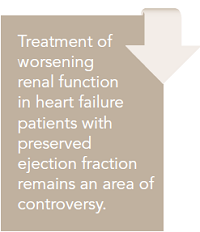ARBs and the Impact of Worsening Renal Function in Heart Failure Patients With Preserved EF
Worsening renal function over time is associated with poorer outcomes in patients with acute and chronic HF. Although this association is established in patients with reduced ejection fraction, there are no data about the relationship between WRF and outcomes in HF patients with preserved ejection fraction.

Jimena A. Blandon, MD
Review
Damman K, Perez AC, Anand IS, et al. Worsening renal function and outcome in heart failure patients with preserved ejection fraction and the impact of angiotensin receptor blocker treatment. J Am Coll Cardiol. 2014;64(11):1106-1113.

Heart failure (HF) has become a major global public health concern, affecting about 10% of men and 60% of women by the age of 60 years.1 The prevalence in developing countries is approximately 2%, and the numbers increase as the population grows older; its prevalence in the United States alone has risen overall to approximately 5.7 million. Nearly 500,000 new cases are diagnosed each year, causing more than 55,000 deaths annually.2
Worsening renal function (WRF) over time is associated with poorer outcomes in patients with acute and chronic HF. Although this association is established in patients with reduced ejection fraction (HFrEF), there are no data about the relationship between WRF and outcomes in HF patients with preserved ejection fraction (HRpEF). Controversy exists as to whether WRF is always associated with poor outcome.
The goal of the present study by Damman and colleagues3 was to investigate the relationship between WRF and outcomes in patients with HFpEF, and to examine the interaction of the renin-angiotensin-aldosterone system (RAAS) blockade. Researchers investigated change in estimated glomerular filtration rate (eGFR) over time, the occurrence of WRF and its association with clinical outcomes, and interaction with randomized treatment in patients with HFpEF who were part of the I-PRESERVE (Irbesartan in Heart Failure with Preserved Ejection Fraction) trial.4 I-PRESERVE investigated both the relationship between WRF and outcomes in patients with HFpEF and the interaction with RAAS blockade in treatment with angiotensin receptor blocker (ARB) medications.
Study Details
I-PRESERVE was an international, double-blind, placebo-controlled study with results initially published in 2008. The original trial included 4128 patients at least 60 years of age; NYHA class II, III, or IV heart failure; and an ejection fraction of at least 45%. The patients were randomized to receive placebo or irbesartan 300 mg/d. The present trial enrolled 3595 patients (87% of all randomized patients) divided into 2 groups: 1659 received irbesartan and 1707 received placebo. Both groups had similar characteristics at admission and randomization: EF >45%, elevated brain natriuretic peptide (BNP; >400 pg/mL) or N-terminal prohormone of BNP (NT-proBNP; >1600 pg/mL), and a serum creatinine (SCr) level >221 mmol/L (2.5 mg/dL).
These 2 groups were similar with regard to renal function (mean GFR, 74-75 mL/min/1.73 m2) type 2 diabetes (3.8% in irbesartan, 3.6% in placebo group), hypertension, coronary artery disease, and atrial fibrillation. Applied criteria for exclusion was baseline SCr >2.5 mg/dL, renal impairment (eGFR ≤40 mL/min/1.73 m2), hyperkalemia >5 mEq/L, and comorbid conditions that signified expected survival of less than 3 years.
The treatments and stages of heart failure were similar in the 2 groups. The patients were randomized to receive either irbesartan starting at 75 mg/d, with the dose being doubled to 150 mg/d after 1 to 2 weeks and increased up to 300 mg/d after an additional 1 to 2 weeks as tolerated, or placebo. The patients were followed every 2 weeks for 8 weeks, and then at 6, 18, and 30 months.
The primary outcome was defined as the first occurrence of cardiovascular (CV) death or HF hospitalization (eg, worsening EF, unstable angina, myocardial infarction, ventricular arrhythmia, atrial arrhythmia, or stroke). Secondary outcomes included all-cause mortality, HF hospitalization, the combined end point of all-cause mortality, or HF hospitalization.
During a median follow-up of 46 months, the primary outcome (CV death or HF hospitalization) occurred in 895 patients (24.9%). A total of 85 patients (37%) with WRF (HR, 1.97; 95% CI, 1.41-2.17; P = .001) and 810 patients (24%) without WRF reached the combined outcome. In univariate analyses, WRF was consistently associated with an increased risk of developing the primary outcome and was related to poor clinical results. Patients affected by renal failure in the irbesartan group were more likely to reach the primary outcome. The secondary end points were reached in a similar magnitude in patients with WRF, but after multivariate adjustment, the interaction between treatment allocation and WRF on the effect of CV death or HF hospitalization was no longer significant—although it remained so for all-cause mortality.
Notably, drug discontinuation rates were very low, with no difference observed between the placebo and irbesartan groups. Patients in the irbesartan group who developed WRF exhibited a significantly greater reduction in mean arterial blood pressure (MAP) at 8 weeks compared with those who did not experience WRF. In a mixed-effect linear model, changes in MAP showed a significant positive association with changes in eGFR over time, and there was a significant multivariate adjusted interaction between irbesartan treatment allocation, changes in MAP, and changes in eGFR over time (P = .004).
CommentaryAre the findings solid enough to draw conclusions?
This study reflects the fact that WRF was associated with a bad clinical outcome in CV mortality and HF hospitalization. This primary end point was detected in 37% of patients with WRF versus only 24% of patients without WRF (P <.001). Univariate analysis showed that patients with HFpEF who were taking irbesartan had twice the risk of WRF and reaching the primary end point. Using a multivariate analysis, WRF was associated with the primary outcome in the overall population and the irbesartan group, but not in the placebo group.
WRF is a well-known and expected manifestation of RAAS system inhibition, and has been thought to be a marker of successful suppression of highly elevated and deleterious renin and aldosterone levels.5 WRF occurs in both systolic and diastolic heart failure and with both angiotensin-converting enzyme (ACE) inhibitor and ARB treatment. The exact mechanism involves a renal perfusion and decreases in systemic blood pressure, tone in efferent arteriolar vasoconstriction, glomerular perfusion pressure, and filtration.
The present study found a 6% to 14% incidence of WRF depending on definition criteria, which is similar to the incidence of WRF observed in other studies using other RAAS system blockers. However, multivariate adjustment failed to show a significant relationship between WRF and allocation to irbesartan or placebo with the primary outcome, although it was positive for all-cause mortality.
In retrospective analysis of previous clinical trials using ACE inhibition in patients with HFrEF, the occurrence of WRF has been associated with a better prognosis, as shown in the SOLVD study, where patients in the enalapril group who developed WRF had a better prognosis than those with WRF in the placebo group.5 In the SAVE study, patients treated with captopril who developed WRF had better outcomes than those developing WRF in the placebo group.6 Similar results were seen with the use of eplerenone, a mineralocorticoid receptor antagonist, and with valsartan, an ARB agent.7,8
In contrast with the findings on the Val-HeFT study, which used valsartan in patients with HFrEF, the initiation of irbesartan in this population was associated with a higher incidence of critical events rate-independent of other risk factors. The Val-HeFT investigators theorized that irbesartan did not have an overall benefit and thus could not counterbalance the negative effects on renal function. In the present study by Damman et al, the patients in the irbesartan group may have had more venous congestion and water and salt retention given the fact that they had higher levels of NT-proBNP.
Other limitations of this study are important to discuss, including that it is a retrospective study. In addition, patients taking irbesartan did not have any overall improvement, and only a small subset of patients (229 of 3595) developed WRF, making it difficult to make solid conclusions. It is thus possible that the findings reflect only serendipity.
In conclusion, randomized controlled trials that assess the relationship between WRF and hard CV events (eg, death, hospitalizations, worsening HF) in patients with HFpEF treated with RAAS inhibitors are much needed before it will be possible to conclude that ARB agents, such as irbesartan, are not effective or are undesirable in treating this group of patients.
References
1. Roger VL, Go AS, Lloyd-Jones DM, et al. Heart disease and stroke statistics—2012 update: a report from the American Heart Association. Circulation. 2012;125:2-220.
2. Kochanek KD, Xu JQ, Murphy SL, Miniño AM, Kung HC. Deaths: final data for 2009. National Vital Statistics Reports. 2011;60(3). CDC website. www.cdc.gov/nchs/data/nvsr/nvsr60/nvsr60_03.pdf.
3. Damman K, Perez AC, Anand IS, et al. Worsening renal function and outcome in heart failure patients with preserved ejection fraction and the impact of angiotensin receptor blocker treatment. J Am Coll Cardiol. 2014;64:1106-1113.
4. Massie BM, Carson PE, McMurray JJ, et al. Irbesartan in patients with heart failure and preserved ejection fraction. N Engl J Med. 2008;359:2456-2467.
5. Testani JM, Cappola TP, McCauley BD, et al. Impact of worsening renal function during the treatment of decompensated heart failure on changes in renal function during subsequent hospitalization. Am Heart J. 2011;161:944-949.
6. Jose P, Skali H, Anavekar N, et al. Increase in creatinine and cardiovascular risk in patients with systolic dysfunction after myocardial infarction. J Am Soc Nephrol. 2006;17:2886-2891.
7. Rossignol P, Cleland JG, Bhandari S, et al. Determinants and consequences of renal function variations with aldosterone blocker therapy in heart failure patients after myocardial infarction: insights from the Eplerenone Post-Acute Myocardial Infarction Heart Failure Efficacy and Survival Study. Circulation. 2012;125:271-279.
8. Lesogor A, Cohn JN, Latini R, et al. Interaction between baseline and early worsening of renal function and efficacy of renin-angiotensin-aldosterone system blockade in patients with heart failure: insights from the Val-HeFT study. Eur J Heart Failure. 2013;15:1236-1244
About the Author
Jimena A. Blandon, MD, is a fellow in nephrology at Cleveland Clinic Florida in Weston, Florida. Dr Blandon completed her residency in internal medicine at the Paul Foster School of Medicine at Texas Tech University Health Sciences Center in El Paso, Texas. She received her MD at Universidad del Valle in Cali, Colombia.
